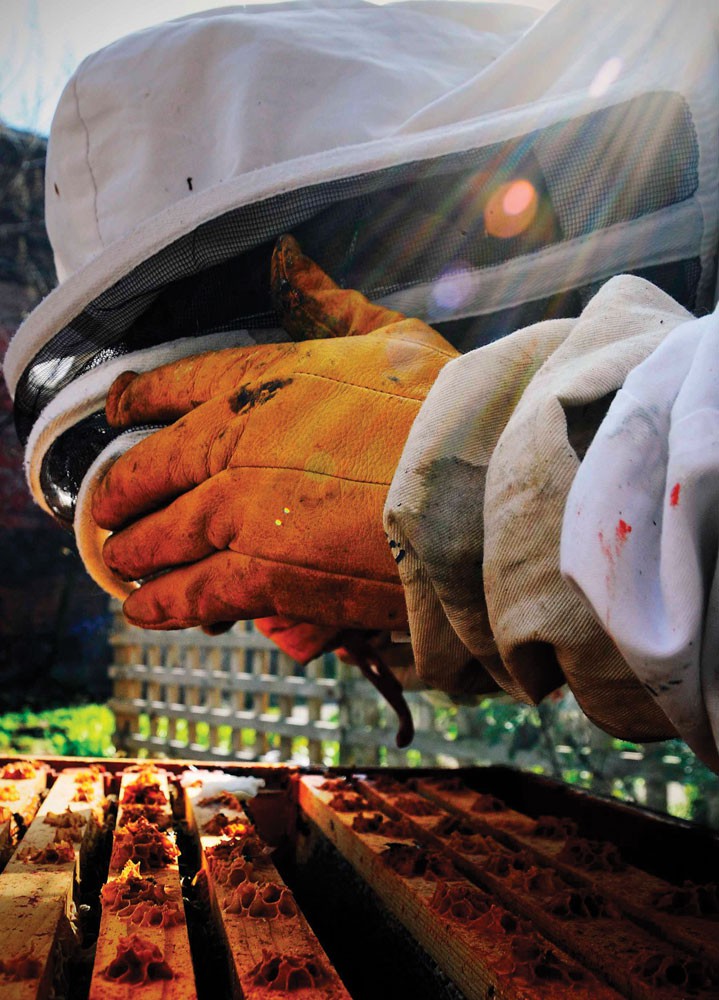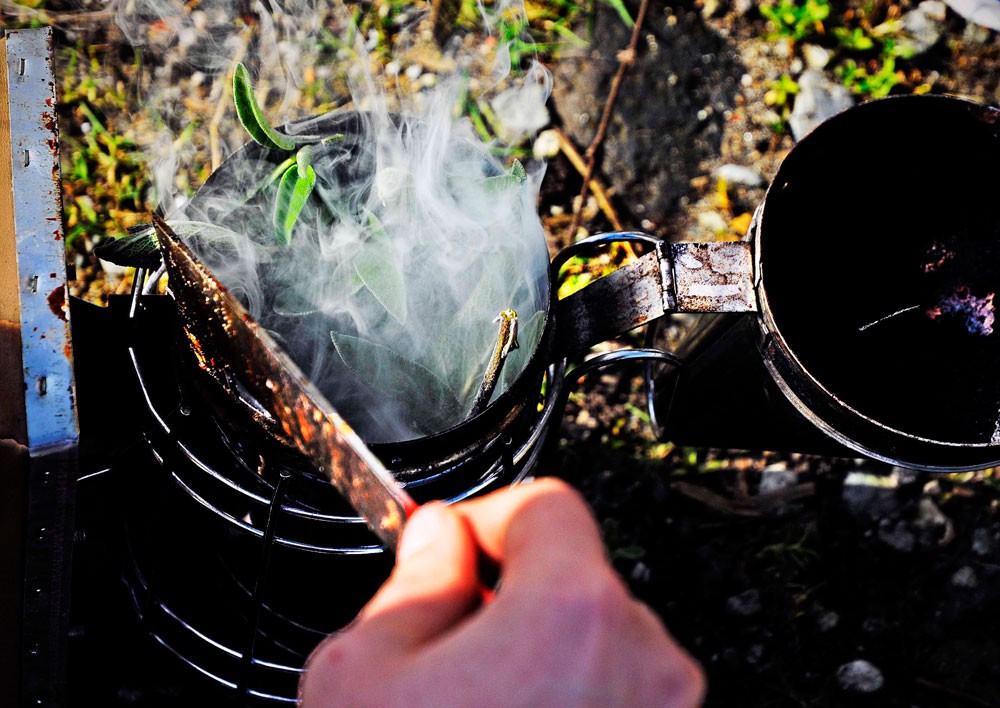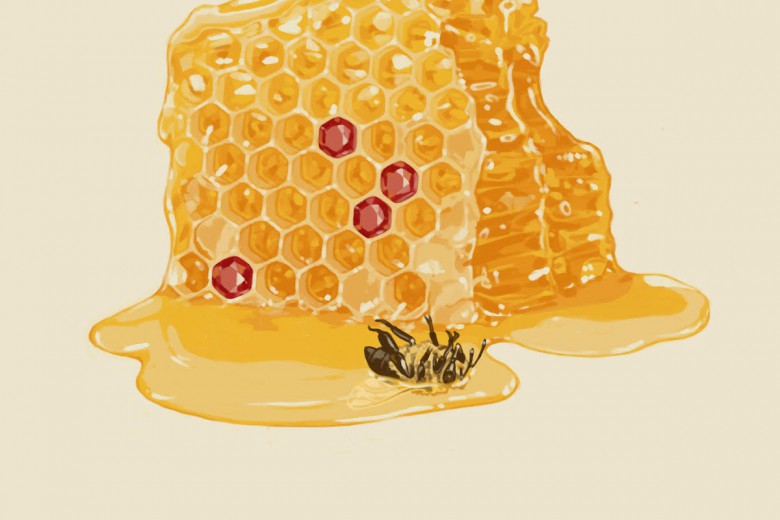
Just a drop of dark honey and the full-bodied flavour, steeped in the comb, takes over your mouth: caramel undertones and thick molasses scent. “You can actually line up the honeys from the neighbourhoods and always know the Hastings honey,” Julia Common tells me as I sit with her and her daughter, Sarah Common, in East Van Roasters. “You can taste it. There’s a certain flavour that hits you as you get closer to the heart.”
The heart is a hive named Elizabeth. It was the first one they set up in Vancouver’s Downtown Eastside (DTES), back in June 2012. They didn’t expect it to produce honey but wanted to share the experience of beekeeping, believing it could be “a powerful way to pull people out of their chaos.”
Against expectation, Elizabeth created 40 litres of honey that summer, twice the amount of Julia’s hives on pristine farmland near Tsawwassen. More than that, community members showed a talent for beekeeping and were leading peer workshops in apiculture by September. Today, Hives for Humanity manages 72 hives throughout downtown Vancouver and has a supply of rich, raw honey it sells to sustain the project.
Sarah begins to tell me about the early days of the project. She had the idea after seven years working with the Portland Hotel Society and seeing the therapeutic impact of people getting their hands in soil. But her story is interrupted when I look up and realize Julia is on the verge of tears. “I can’t help it,” she says as she removes her glasses.
Sarah gives me an impish glance and a half-smile as she rubs her mother’s shoulder. “I’m just such a doofus,” Julia continues. “I didn’t want to be down here. Then in the middle of the first summer, we’d just had our first taste of honey. Jim, a volunteer, is looking at the bees and he says, ‘Next year, could we make two out of this one?’ Of course, he’s completely spot on. That’s what you do. I ask my daughter, ‘Does anyone talk about the future down here? Because I’m talking to Jim about spring.’”

Jim, a peer mentor at the Drug Users Resource Centre, also known as LifeSkills, was the inspiration to expand the project and give it a name. I meet him an hour later in the small community garden behind Vancouver’s safe injection facility, InSite.
There’s nothing blooming in December, but there’s still plenty to see: in the south corner, a women’s bench with a dedicated plaque and memorials, and at the north end, the bare wood structure of a sweat lodge. “A lot of people are trapped within these three blocks,” Jim tells me. “This is the only green space. Respect for it is high.”
He moves and speaks gently as he shows me around, speaking about the moods of the bees, how they recognize the keepers by their scent. He points out where they project movies in the summer against the brick wall of InSite, then finally brings me to the west wall, to Elizabeth, the heart of the network. The hive is unremarkable, a hand-painted box on a stand. But inside, 60,000 bees have joined into a mass at the centre, protecting one another. At least, that’s everyone’s hope. There’s no guarantee the bees will make it through winter.

Some winter die-off is normal. But today, even the most committed, organic beekeepers open their hives in spring and find them barren. Ironically, the bees are more likely to survive in the city than in the countryside. In rural settings, there’s no way to protect them from what’s happening on neighbouring farms.
The three biggest threats are almost always present: genetically modified (GM) plants that can be difficult for the insects to process, monoculture crops that offer only a limited period for pollination, and the use of neonicotinoid pesticides. In fact, cities are the only places where bee populations are steadily increasing. Municipal regulations have been changed from New York to Vancouver to allow people to keep hives in urban centres, and thousands of people are choosing to do so. In the absence of pesticides and GM monoculture crops, honeybees are proving they still have the ability to thrive.

The evidence connecting neonicotinoids to colony collapse disorder resulted in a ban of the use of these pesticides by the European Union, instituted December 1, 2013. No such ban exists in North America. The Canadian Honey Council, an organization representing 7,000 apiarists, estimates that Canada has lost 35 per cent of its bee population in the last three years.
Later that day, I sit with a man in the main room of LifeSkills. Ian smiles shyly under his worn, red baseball cap. He lives in a single room occupancy suite (SRO) operated by the Portland Hotel Society and got involved in the project when a notice about the arrival of the bees was slipped under his door. Now he’s the main caretaker of five hives. “It gives me the sense that I’m actually protecting humanity by protecting the bees,” he says quietly, and shrugs. “I’m making sure that there’s going to be food and pollination. A little strange, but it means a lot to me.”

As the room blossoms around us, filling with loud conversations and laughter, people taking shelter from the cold and doing laundry in the community machines, Ian shifts in his seat and admits he’s not the most social person. “I’m not involved in the alcohol or anything, so I didn’t really have a reason to go outside. But the bees forced me to go out into the community.
Now people see me around and say, ‘There goes the bee guy.’ I mean, how much alone time does a person really want in their life?” I nod and laugh gently with him. “Our back deck used to be nothing but people throwing garbage out there,” he adds. “Now we’ve got a garden. People that normally wouldn’t say anything to each other are out there together all summer long.”
It sounds like Ian is reciting poetry when he describes the bees: how they communicate the source of pollen, its distance and quantity, through a dance performed completely in the dark, how they trust and follow one another, constantly working to a greater purpose. I begin to lose myself in a vision of LifeSkills slowly transforming into an intricate honeycomb that hums as each person performs their own small task: a social worker whistles as he passes, a couple shares noodles from a Styrofoam container while smiling deeply at each other, the dryer tosses sleeping bags, two men laugh.
Then Ian looks up at me, the expression on his face changing. “If the human race were structured more like bees, you’d never have a problem in your life knowing where you’re suppose to be. As soon as they emerge from their cell, they’ve got a job to do. If humans were born that way, having everything they needed …” And the vision, delicate as it was, fades.

The truth is, both communities are living on a precipice. Their resilience doesn’t change the fact that they are under threat. Ian routinely scrapes propolis from the hives, grinds it up, and places it in propanol to make liquid bandages. The tincture can treat the bedbug bites he and his neighbours receive living in SROs, but it can’t change the housing crisis in Vancouver, the gentrification of the DTES, or the fact that welfare provides only $375 per month for housing.
Still, Ian is hopeful. “You know, humans are the most resilient of all creatures,” he says as we zip up our jackets and head back out into the cold. “There’s no difference between someone living on the street to someone living in a home. It’s survival. The guy who lives on the street may become a little harder because he always has to be on his guard. We adapt, just like the bees adapt.”
Later that night, I eat the honey with a spoon, letting each mouthful dissolve. The flavour is deep and unexpected. There’s no way to separate it from the voices of Ian and Jim now, from that small painted hive and the blue felt hearts I saw woven into the garden fence when I left.
I remember the words of Vandana Shiva, whose activism focuses on our rights to seeds: “The beauty of the seed is out of one you can get millions. The beauty of the pollinator is it turns that one into millions and that’s an economics of sharing. That’s to me the real economics of growth because life is growing.” The beauty of the pollinator is the beauty of the beekeeper, I think. And this rare honey, maybe it’s just the taste of life growing, wherever and however it can.



